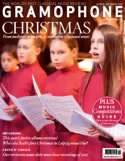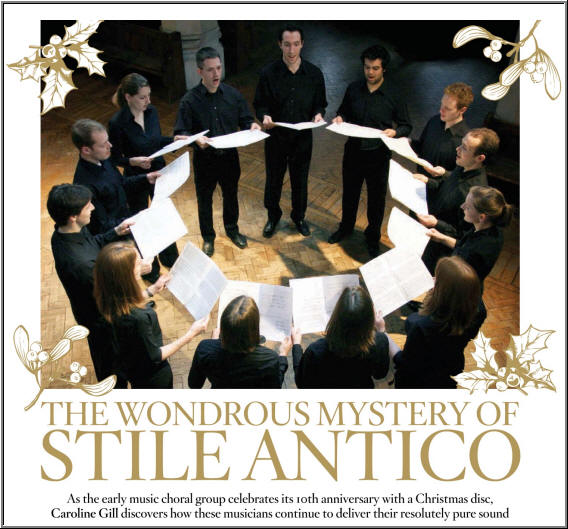Texte paru dans: / Appeared in: |
|
|
Outil de traduction (Très approximatif) |
|
|
Stile Antico, 10 Years on - by Caroline Gill
Andrew Griffiths, who sings
bass with Stile Antico, is beaming when he sits down with his chorus mates
Eleanor Harries and Rebecca Hickey. They have spent the first session of the
day working on Hieronymus Praetorius’s Magnificat for the group’s new disc
of Flemish and German Christmas music, and Griffiths is particularly upbeat
about it. ‘There’s a magic number between eight and 12 parts where it all
gets very hard,’ he says. ‘But doing the Magnificat this morning was small
enough for you to be able to think about it like a string quartet.’ There is a sense of relaxed relief in the air that things are going well, despite the amount of music the group has to cover for this recording, and everyone collapses happily into chairs, with tea and cake, to talk over the years since the group’s beginnings. 2015 has been a year of 10th celebrations for Stile Antico. A 10th birthday recital at London’s Wigmore Hall in July and an extensive tour of the United States – their 10th – as well as these sessions on their 10th disc have all served to illustrate how far the group has come over those years. Since their success at the York Early Music Festival in July 2005 they have established a unique niche in the choral music arena with their resolutely pure sound. It is one that has evolved less in weight, volume and depth, and more in the degree of perfection to which that purity has been honed. It is also one that is particularly well suited to the repertoire on ‘A Wondrous Mystery’: the Christmas disc that is causing so much infectious humour between them today.
Although there are pieces on this recording that make their way onto the vast majority of releases of early Christmas music – Michel Praetorius’s Es ist ein Ros entsprungen is no stranger to any number of those examples, from the Choir of King’s College, Cambridge, to recorder arrangements by Michala Petri – the majority do not. It is a blend of formal and informal polyphony, interspersed with music that is more redolent of folk dance than the purest of High-Church heritage from which it purports to come. Übers Gebirg Maria by Johannes Eccard, Kapellmeister in Berlin in the late 16th century, is an infectious but highly polished piece of church homophony, whereas the Hieronymus Praetorius Magnificat incorporates references to ancient carols such as Josef lieber, Josef mein. It is repertoire at opposite ends of a spectrum with which Stile Antico is intimately acquainted, although that’s not to say that this repertoire is not a challenge for them. ‘Much of it is slightly counter-intuitive for us,’ says Griffiths. ‘Homophonic music can be harder than polyphony, where at least you can react to something that’s going on the whole time. With homophony you have just got to get everything perfectly together.’
This is a particular challenge, I suggest, for a group that works without a conductor. It is enough of a challenge for smaller ensembles that work in a similar way, such as Gallicantus or the Queen’s Six. Stile Antico’s size, however – they rarely sing with fewer than their full complement of 12 – presents even bigger challenges with ensemble and tuning. ‘For any new concert programme there will be in the region of 12 three-hour rehearsals,’ says Griffiths, ‘which I’d hazard is two or three times as much as any conducted group.’
There are plenty of details to hone without the fallback of a conductor-centric dictatorship, and I wonder whether the group has a consciously drawn hierarchy to help work through what must be inevitable differences of opinion. ‘I also work as a conductor,’ says Griffiths, ‘and if I’m working with a choir, I would expect a member to think twice before they suggest anything. But for us there is a house style that has emerged over 10 years – there’s now quite a lot that just doesn’t need discussing.’
That doesn’t really answer the question of whether there is a hierarchy, but allowing the conversation to wander onto the specific details of the personnel offers a clearer picture. That the group that burst onto the early music scene in 2005 bears such a close resemblance to the group that is recording today shows not only that is there no interpretative pecking-order, but that there is no need for one. ‘There are still six of us who were there right from the beginning,’ says Hickey, who sings soprano. ‘And apart from one person who came in three years ago, everyone has been in the group for at least six years. It’s really important to have those six who started the group in the first place – the ethos of the group comes from them.’ Is it possible to put into words what that is? ‘It’s the love of the music,’ says Hickey, emphatically. ‘And the fact that we’re doing it because we want to explore the music, and give it the best performance we can give.’ This is an important point, and one borne out as clearly in visual terms as it is aurally when watching the group rehearse.
Standing in the formation of a wide arch in the church of All Hallows, Gospel Oak – with its sympathetic acoustics and unusually quiet urban location – the group walks an aural tightrope between spreading out far enough to create a space around the sound and defining each voice part enough to enhance the idiosyncracity of their purity of sound. The group’s size makes it difficult to imagine how they can sing together as they do without a director. One might think that staying together in pitch and beat is so demanding without one that there is no intellectual or musical room to pay attention to the stylistic elements of the music they are singing. Yet they not only breathe as one – particularly noticeable at the beginnings and ends of phrases – but they also move through the phrases in a way that makes them look like a single entity.
So how to define the Stile Antico sound, one that, to my ears, remains so ‘traditional’? Although any member of the group would say, rightly, that their sound has matured and deepened over the course of their years together (and, indeed, they laugh when talking about listening to their first disc of music for compline, saying ‘we sound so young!’), it is nevertheless undeniable that there is an old-school purity and lightness to their sound which is defining and undeniably appealing. In many ways, as a listener, the sound – with considerable emphasis on a searingly pure top line – is a refreshing return to that of vocal ensembles of the 1990s. It is too simplistic to say that it is redolent of the completely straight and meticulous sound of Trinity College Choir under Richard Marlow, for instance, who strove to leave the sound understated enough for the music to speak for itself with minimal interpretative interference. Stile Antico may make a sound which is in that tradition, but two generations on, and without the responsibility of presenting this repertoire to an audience as completely new music, there is now more space for artistic expression.
‘Part of our ethos is to do with how we work as a group,’ says Griffiths, ‘as well as just the music itself. I think that influences the sound, that being aware of the whole texture in a way that we might not if it was simply concentrating on how you sing according to one person at the front.’
The perfection of the tuning and blend is such that Robina Young, Harmonia Mundi’s distinguished producer and a long-time collaborator with Stile Antico, will very rarely pipe up from the box that something needs doing again due to intonation issues. She works, instead, to ensure that their long, arching single takes inject a deeper degree of coherence into the music than is possible with several short takes, however perfect an impression of tuning and blend those may give.
So, do they have a plan for the next 10 years? Many umms and ahhs between the three – the democracy evident even in the kitchen of All Hallows – end with alto Harries venturing that 10 years might be a bit far to plan ahead. Five, then? ‘Oh, well – to keep on building repertoire,’ says Griffiths firmly. ‘Which is happening. To do more Continental repertoire, more of the early music, and more one-to-a-part.’
For now, though, this quietly elegant group is happy as it is, with the notes on the page and delivering their customary pure performances of beautiful music. |
|
|
|
|
|
Cliquez l'un ou l'autre
bouton pour découvrir bien d'autres critiques de CD |
|




